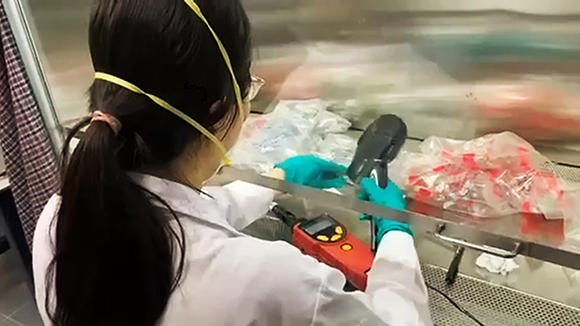A technician prepares samples for analysis. Courtesy of Chulalongkorn University
The faculty members and students of the Department of Chemistry at Chulalongkorn University have successfully developed, for the first time, a quick and easy-to-use portable sweat test device for COVID-19 to detect specific scents in sweat caused by bacteria. Sample collection only takes 15 minutes per person, and the results can be obtained in 30 seconds. The sweat test is now being used in community screening.
This is based on the success of the “COVID-19 Sniffer Dogs” project which has been a collaboration between the faculty of veterinary science, the faculty of science, Chulalongkorn University, and Chevron Thailand Survey and Production Co., Ltd. — using sweat sniffer dogs to detect asymptomatic COVID-19 cases in the community. Today, the “Portable Sweat Test for COVID-19 Detection” is announced as the latest innovation to supplement the army of sniffer dogs in accelerating and extending the coverage of community screening.
“Previously, we worked with ‘Sniffer Dogs Mobile Units’ in the field to test for COVID-19 in communities with at-risk groups. So, we took the samples that the dogs found and searched for specific substances that the dogs could detect,” explained Dr. Chadin Kulsing, of the Department of Chemistry, Faculty of Science, Chulalongkorn University, about the development of the innovation.
“From the samples, we found that people infected with COVID-19 secrete very distinct chemicals. So, we used this finding to develop a device to detect the specific odors produced by certain bacteria in the sweat of COVID-19 patients. This is the first time that COVID-19 is detected via these chemicals.”
People’s sweat may have more than 100 unique scents — be it from the powder, roll-on deodorant, or the bacteria that feed on sweat or skin secretions, then excrete the substances that are mixed with sweat.
“For those infected with COVID-19, the bacteria react abnormally to the virus and produce some distinct odors unique to COVID-19 infection,” Chadin explained.
The portable sweat test device was developed from a commercially available portable chemistry analyzer which is generally used to measure chemicals that are toxic to the environment. To adapt it to detect COVID-19, Chadin installed a specific filter to detect the virus.
“The test kit consists of a glass vial and a cotton swab which screeners will receive one each. The screeners would place the cotton swab under the armpit of the person receiving the test and leave it for about 15 minutes. After that, the cotton swab is put in the glass vile, which is then sterilized with UV rays. The technician then draws an appropriate amount of the sample using a suction hose, and pressurizes it into the analyzer to check the results,” said Chadin.
The advantage of this method is that it can be adapted to detect mutated variants of the virus or other microorganisms.
“Even with mutated variants, the chemical odor in the sweat of an infected person will be different from that of the uninfected. So, the equipment should be able to handle the variable chemicals with just a change of filter,” added Chadin.
Field tests of the device on 2,000 people alongside the PCR (Polymerase Chain Reaction) testing found the results to be on a par – with 95% sensitivity and 98% specificity. However, Chadin recommends that if the sweat test shows positive results, patients should also get a PCR test for confirmation.
At present, the portable sweat test device for COVID-19 is still in the research and development phase, with Chula in collaboration with the Department of Disease Control and government agencies conducting tests in various communities.
“This device can help with proactive screening in the communities with emerging clusters. We also work with the “Sniffer Dogs Mobile Units” to take over from the canines during their rest period,” Chadin concluded.
Source: Chulalongkorn University
